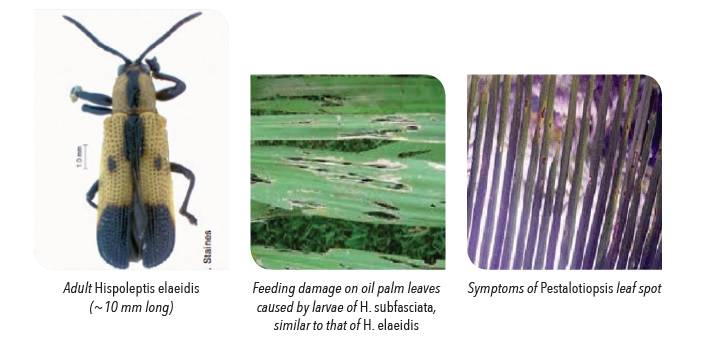General information

Hispoleptis elaeidis is a pest of Elaeis guineensis in Colombia and in Ecuador. The female beetle forms small depressions in the undersurface of leaves, where it lays eggs in pairs. The larvae mine leaves during feeding, and the pupae remain in the mine. Recently emerged imagoes remain in the tunnel for a few days before cutting an exit hole and leaving the mine. Adult beetles eat long strips of leaves.
Defoliation occurs at all levels of the palm. In severe infestation, almost all leaflets are shredded and dry out. Feeding damage provides access to secondary infection of the foliar fungus, Pestalotiopsis palmarum.
First symptom of Pestalotiosis leaf spot is the development of small brown spots with yellowish haloes. As the disease progresses, the spots coalesce into brown necrotic areas that spread throughout the leaves. The leaves eventually turn grey and brittle. The condition can occur at any stage of the palm, but is generally more severe in plantations over five years and can cause higher production reductions (up to 36% due to decline in photosynthetic capacity of the leaflets). Bunch reduction of as much as 18 to 20 t ha-1, and crop loss of up to 40% due to this disease have been recorded.
Distribution
South-western Colombia and western Ecuador.
Detection and Inspection
Limited literature available on H. elaeidis. Life history may be similar to H. subfasciata. Adult beetles have distinctive markings on elyctra (i.e. two black spots above the dark dorsal area) .
Prevention and Control
PHYTOSANITARY
Eggs and young larvae are difficult to detect via visual inspection. Only the larger mature adults are more likely to be detected. Source germplasm from pest free areas, and ensure sanitation from sourcing to shipping. The import of germplasm material (seeds, pollen, tissue culture) must be accompanied by an import permit issued by or on behalf of the Director-General of Agriculture for Peninsular Malaysia (including Labuan), or the Director of Agriculture for Sabah, and a phytosanitary certificate issued by an authorised official from the country of export. The import conditions are available upon request from the Plant Biosecurity Division Malaysia. All consignments are subjected to inspection by the Agricultural Department prior to clearance by Customs. Germplasm material imported from high risk areas should be sent for third country quarantine before arrival onto Malaysian shores. The import of alternative host plant parts i.e. Cocos nucifera from infested areas should be enquired with DOA.
CULTURAL CONTROL AND SANITARY METHODS
Effective control was possible with monocrotophos applied by a root absorption method or injected into the stems.
Further reading
- Corley, R H V and Tinker, P B H (2003). The Oil Palm (4th edition). Blackwell Science Ltd: USA. 592 pp.
- Hill, D S (1975). Agricultural insect pests of the tropics and their control. Cambridge University Press: UK. p 608-610.
- Howard, F W; Moore, D; Giblin-Davis, R M and Abad, R G (2001). Insects on Palms. CABI Publishing: UK. 400 pp.
- Labarca, M; Sanabria, N and Arcia, A (2006). Pestalotiopsis palmarum Cooke pathogenicity on nursery-oil palm (Elaeis guineensis Jacq.) plants. Rev. Fac. Agron. (LUZ) 23: 414-421.
- Le Verdier, A And Genty, P (1988). Damage and control of Hispoleptis subfasciata Pic., a phyllophagous hispine of oil palm in Latin America. Oléagineux, 43(11): 397- 407.
- Mariau, D (2001). The Fauna of Oil Palm and Coconut: Insect and Mites Pests and Their Natural Enemies. La Librairie du Cirad: France. 264 pp.
- Staines, C L (2012). Catalog of the hispines of the World (Coleoptera: Chrysomelidae: Cassidinae). Tribe Hispo-Leptini. URL: http://entomology.si.edu/ coleoptera/hispines/PDFs_2012updates/Hispoleptini- 2012revision.pdf

